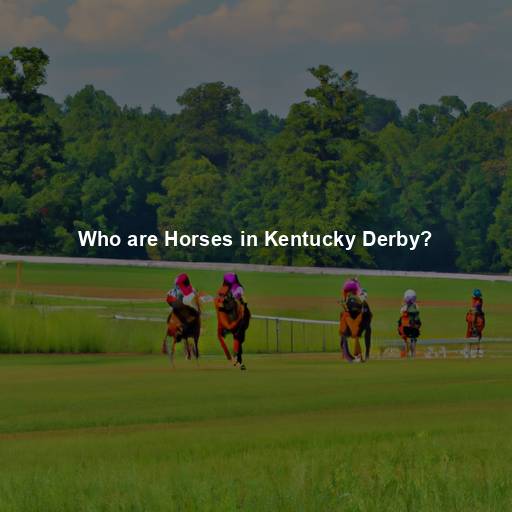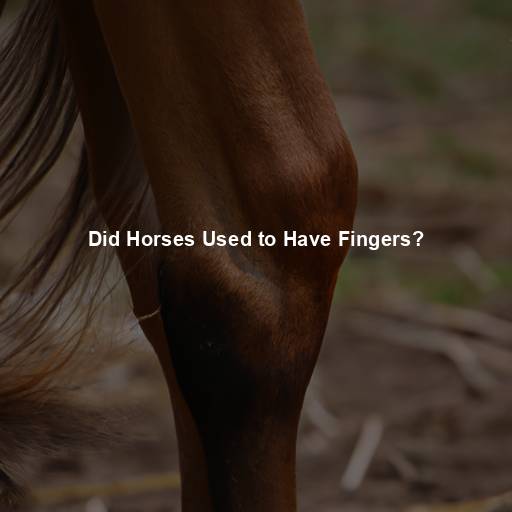What Horses Are Used For Racing?
Last Updated on July 21, 2023 by Evan
Contents [hide]
- 1 Understanding the World of Horse Racing
- 1.1 Thoroughbred Horses: The Epitome of Horse Racing
- 1.2 Flat Racing: The Classic Horse Racing Experience
- 1.3 Steeplechase: The Thrill of Jumps and Obstacles
- 1.4 Harness Racing: The Art of Trotting and Pacing
- 1.5 Quarter Horse Racing: The Need for Speed
- 1.6 Endurance Racing: Stamina and Determination
- 1.7 Racing Ponies: Small Size, Big Talent
- 1.8 Standardbred Horses: Harnessing Speed
- 1.9 Quarter Horses: Sprinting Champions
- 1.10 Arabian Horses: Endurance and Stamina
- 1.11 Pony Races: A Platform for Young Riders
- 2 Different Types of Horse Racing
- 3 The Thrill and Artistry of Horse Racing
- 4 FAQs – What Horses are Used for Racing?
- 4.1 What are some common horse breeds used for racing?
- 4.2 What qualities make a horse suitable for racing?
- 4.3 At what age do horses start racing?
- 4.4 Are racehorses only used for racing?
- 4.5 How are racehorses trained for racing?
- 4.6 Are all racehorses geldings?
- 4.7 How long do racehorses typically race for?
Understanding the World of Horse Racing
For centuries, people have been enthralled by the mesmerizing allure of horse racing. This timeless sport effortlessly weaves together the majestic grace of these magnificent creatures, the unparalleled expertise of jockeys, and the electric atmosphere of fierce competition. As we embark upon a journey through the annals of equine history, we shall unveil the kaleidoscope of races and the captivating assortment of breeds that have graced the hallowed tracks. Prepare to be fascinated by the intoxicating world of horse racing, where excellence and exhilaration converge in an enigmatic ballet of hoofbeats and adrenaline.
Thoroughbred Horses: The Epitome of Horse Racing
When it comes to horse racing, one breed stands out above the rest – the Thoroughbred. These magnificent creatures are considered the epitome of horse racing. Known for their speed, agility, and endurance, Thoroughbreds are specifically bred and trained for racing. They possess a combination of traits that make them excel on the racetrack.
Thoroughbreds are known for their lean bodies, long legs, and deep chests, all of which contribute to their remarkable speed and stamina. Their genetic makeup is carefully selected to enhance their racing abilities, with a focus on traits such as cardiovascular capacity, lung capacity, and muscle strength. These horses undergo rigorous training to develop their natural athleticism and racing instincts.
Flat Racing: The Classic Horse Racing Experience
Step into the world of horse racing, where the thunderous hooves create a symphony of excitement and the air is thick with the anticipation of victory. At the heart of this ancient sport lies flat racing, an iconic spectacle that has captivated millions for generations. With its unobstructed tracks and adrenaline-fueled competitions, flat racing embodies the epitome of speed, endurance, and equestrian mastery. It is a realm where thoroughbred stallions and mares reign supreme, captivating the imaginations of spectators from the storied grounds of the Kentucky Derby to the glitz and glamour of the Royal Ascot and the unfathomable riches of the Dubai World Cup.
There’s a certain enchantment to flat racing, a captivating dance between grace and chaos. It’s a vibrant tapestry of sights and sounds that bewitch spectators across the globe. The resounding thud of hooves hitting the track, the kaleidoscope of vibrant jockey silks, and the palpable surge of energy from the crowd create a symphony of exhilaration. With each race, the sheer might of these equine athletes and the strategic mastery of jockeys intertwine, leaving hearts racing and breaths held in suspense.
Steeplechase: The Thrill of Jumps and Obstacles
For those seeking a thrilling twist to the already exhilarating world of horse racing, the enigmatic realm of steeplechase beckons. Hailing from its Irish roots, this riveting sport with a penchant for perplexity has swiftly captivated audiences across the globe. As the courses unfold, horses gracefully leap, adroitly maneuvering over vividly adorned hurdles and fences, putting their jumping prowess and nimbleness to the ultimate test. Prepare to be awe-struck by the heart-pounding spectacle that is steeplechase.
When it comes to the exhilarating world of steeplechase, one thing is crystal clear: it’s a whole different ball game compared to flat racing. Whisking spectators away on an adrenaline-fueled ride, steeplechase demands a unique set of skills from its equine participants. These daredevil horses not only possess lightning-fast speed and agility, but they also embody the bravery and confidence needed to leap over formidable obstacles with unwavering determination. Thrilling as it may be, steeplechase is undeniably a sport that requires split-second decision-making, as these magnificent creatures must rely on their innate ability to gauge distances and choose their course of action with astounding precision.
Harness Racing: The Art of Trotting and Pacing
While Thoroughbreds dominate the world of flat racing and steeplechase, another breed takes the spotlight in harness racing – the Standardbred. Harness racing involves horses pulling a two-wheeled cart called a sulky, with a driver known as a “reinsman” controlling their speed and direction. Unlike flat racing, where jockeys ride the horses, harness racing places more emphasis on the horse’s trotting or pacing style.
When it comes to grace and rhythm, no horse can match the Standardbred. Their seamless gaits, honed through generations of meticulous breeding and training, make them the quintessential choice for harness racing. The power behind their trotting or pacing abilities is simply awe-inspiring, captivating audiences at prestigious events like the Hambletonian and the Breeders Crown. Prepare to be enthralled by the indomitable speed and unwavering stamina of these extraordinary creatures.
Quarter Horse Racing: The Need for Speed
Discover the electrifying world of Quarter Horse racing, where speed reigns supreme over short distances. This exhilarating sport showcases the breathtaking power and agility of the legendary Quarter Horses, celebrated for their unrivaled burst of acceleration and unmatched sprinting prowess. These magnificent, compact equine athletes possess a remarkable combination of muscle and finesse that propels them to reach extraordinary speeds in the blink of an eye. Prepare to be captivated by the sheer intensity and perplexing agility of these awe-inspiring equine marvels as they defy all limits in pursuit of victory.
This type of racing is popular in the United States, where Quarter Horse racing events draw large crowds. The horses’ bursts of speed and the intense competition create an adrenaline-fueled atmosphere. The American Quarter Horse Association (AQHA) is the governing body for Quarter Horse racing and organizes prestigious races like the All American Futurity and the Rainbow Futurity.
Endurance Racing: Stamina and Determination
In the vibrant world of equestrian sports, where grace and agility reign supreme, endurance racing emerges as an awe-inspiring testament to the untamed spirit of horses. While other disciplines may emphasize the lightning-fast pace, endurance racing chooses to raise its flag high in celebration of the horse’s indomitable stamina and unwavering willpower. With races embarking upon treks of 50 to 100 miles or more, this extraordinary sport traverses sweeping landscapes that can oscillate from the formidable deserts to the majestic mountains and enigmatic forests, casting a daunting shadow over both the equine heroes and their intrepid riders.
Arabian horses are a popular choice for endurance racing due to their natural endurance and ability to withstand grueling conditions. These races require careful pacing, as the horse and rider must conserve energy throughout the race to reach the finish line. Endurance racing demands a strong bond between horse and rider, as they navigate challenging terrain and face unpredictable weather conditions.
Racing Ponies: Small Size, Big Talent
Get ready for an unexpected twist in the world of horse racing! It’s not just about the majestic giants anymore; the spotlight is now shining on the pint-sized powerhouses too – the ponies! Brace yourself for the exhilarating journey of young riders as they dive into the intense world of pony racing, taking on the challenge head-on. From local racetracks to prestigious equestrian events, these races are the perfect launchpad for budding jockeys, offering them a taste of the high-stakes competition and an opportunity to leave their mark on the racing world.
Picture this: a dazzling display of pony power, as different breeds like the mighty Welsh, spirited Shetland, and elegant Connemara take center stage. These races, bursting with energy and excitement, serve as a glorious glimpse into the world of equine athleticism. As hooves thunder against the ground, spectators and riders alike find themselves captivated by the sheer speed and agility these ponies possess. It’s an enchanting introduction to the enthralling realm of horse racing, where both thrills and surprises await at every turn of the track.
Standardbred Horses: Harnessing Speed
Harness racing enthusiasts are undoubtedly familiar with the sight of standardbred horses gracefully trotting or pacing around the track. In contrast to their Thoroughbred counterparts, these magnificent creatures are not solely bred for sheer speed, but rather, their remarkable ability to maintain a consistent gait is highly prized. Picture a standardbred effortlessly pulling a sulky, a two-wheeled cart, while under the guidance of a skilled driver, also known as a reinsman, who expertly controls both speed and direction. It is clear why these horses are considered the epitome of smoothness and endurance, making them the perfect contenders for the thrilling world of harness racing.
Quarter Horses: Sprinting Champions
When it comes to the fast and furious world of horse racing, one breed stands out among the rest – the Quarter Horse. These majestic creatures have earned their name for good reason – their lightning-quick sprinting prowess. With their well-defined muscles and powerful hindquarters, they possess a remarkable ability to unleash bursts of speed that leave spectators in awe. Often seen triumphing in short-distance races like sprints and barrel racing, it’s no wonder why the American Quarter Horse Association (AQHA) proudly governs this electrifying discipline, ensuring that excellence continues to flourish.
Arabian Horses: Endurance and Stamina
Arabian horses have long been revered for their unwavering strength and stamina, captivating the hearts of equestrians worldwide. Lorded for their illustrious past in conquering long-distance races, these majestic creatures proudly grace the tracks of endurance competitions. With their sinewy, yet compact frames, Arabian horses effortlessly preserve their energy, embodying the epitome of endurance required for these arduous races that stretch over vast distances, often exceeding the 50-mile mark. Furthermore, their profound connection with their riders and remarkable aptitude for traversing treacherous landscapes have solidified their standing as the darlings of endurance racing aficionados.
Pony Races: A Platform for Young Riders
Pony races provide an avenue for young riders to experience the thrill of horse racing. These races feature ponies, which are smaller in size compared to full-sized horses. Pony racing serves as a stepping stone for young riders to develop their skills and gain experience in a competitive racing environment. Various pony breeds, such as Welsh ponies and Shetland ponies, participate in these races, showcasing their agility and speed.
Different Types of Horse Racing
Flat Racing: The Classic Test of Speed and Endurance
From the electrifying blur of hooves thundering across an even expanse to the palpable anticipation in the air, flat racing emerges as the epitome of equestrian prestige and tradition. Unencumbered by hurdles or obstructions, this timeless pursuit of equine excellence catapults its audience into a realm of pulse-quickening fervor. Striving to crown the fleetest among them, these equine athletes, particularly the majestic thoroughbreds, unfurl their prowess, igniting a fiery spectacle that ignites the passions of both seasoned aficionados and captivated passersby. Immerse yourself in the pageantry of the Kentucky Derby, the regal grandeur of Royal Ascot, or the untamed fervor of the Melbourne Cup, and surrender to the enigmatic allure of flat racing at its zenith.
Endurance Racing: A Test of Stamina and Determination
In the world of equestrian sports, there exists a captivating discipline known as endurance racing. Bound by passion and fueled by the indomitable spirit of the horse, this exhilarating pursuit revolves around the extraordinary feat of covering vast distances. These arduous races, oftentimes spanning beyond the 50-mile mark, serve as litmus tests for both the equine’s unwavering stamina and the rider’s adept horsemanship. Within this realm, the Arabian horse reigns supreme, harnessing its innate endurance and fortitude to navigate treacherous terrain with unwavering determination.
Quarter Horse Racing: Sprinting to Victory
There’s something undeniably captivating about the thunderous gallop of Quarter Horses in the world of high-speed racing. In a flash, these magnificent creatures propel themselves forward, leaving nothing but a trail of wonder in their wake. With races spanning a mere quarter of a mile or less, it’s astonishing to witness the sheer power and agility these horses possess, reaching unimaginable speeds in the blink of an eye. It’s no wonder that events like the illustrious All American Futurity and the dazzling Rainbow Futurity command the attention of passionate racing devotees from far and wide, their hearts pulsating with exhilaration.
The Thrill and Artistry of Horse Racing
There is something undeniably mesmerizing about horse racing, a captivating fusion of athleticism and elegance that transcends mere sport. Every hoofbeat on the racetrack echoes with the roaring heartbeat of a passionate audience, their collective breath held in suspense. It’s more than just a race; it’s a symphony of skillful jockeys and their trusted steeds, dancing harmoniously, connected by an unspoken bond. This is where dreams take flight, where the aspirations of fans, trainers, and future jockeys intertwine, weaving a tapestry of possibility and endless potential.
The world of horse racing is vast and diverse, offering a variety of disciplines and breeds that cater to different preferences and skills. From the elegance and speed of Thoroughbreds in flat racing to the daring jumps in steeplechase, and the endurance of Arabian horses in long-distance races, each discipline brings its unique challenges and thrills.
As we watch these incredible athletes race, let us appreciate the deep bond between horse and rider, the hours of training and dedication, and the sheer beauty of these magnificent creatures. Horse racing is a testament to the incredible partnership between humans and horses, where the pursuit of victory and the love for these animals intertwine in an unforgettable experience.
FAQs – What Horses are Used for Racing?
What are some common horse breeds used for racing?
Horses have long captured our fascination, especially when it comes to the electrifying world of racing. Among the multitude of equine breeds, it is the ever-illustrious Thoroughbred that reigns supreme. Renowned for their unmatched agility, these magnificent creatures embody the epitome of speed and stamina, making them the undeniable darlings of the racetrack. Yet, in the vast tapestry of racing, other breeds like the spirited Quarter Horses, the elegant Arabians, the dependable Standardbreds, and the vibrant Paint Horses also leave an indelible mark on the sport, occasionally rivalling the Thoroughbreds in their quest for glory. However, it is their unyielding dominance and unparalleled horsepower that firmly establishes the Thoroughbreds as the unequivocal superstars of the racing industry.
What qualities make a horse suitable for racing?
When it comes to the thrilling world of racehorses, the stakes are high and the expectations even higher. These magnificent creatures need a potent mix of athleticism, endurance, and sheer determination to vie for glory on the track. A finely tuned physique, with sinewy muscles and lengthy limbs, is a prerequisite for these speed demons. Yet, it’s not just about raw physicality – a racing horse must also have a lionhearted ticker and robust lungs that can power them through the most grueling sprints. But it doesn’t stop there – a harmonious temperament is a vital puzzle piece, ensuring they can maintain their composure amidst the tumultuous whirlwind of training and fiercely competitive races.
At what age do horses start racing?
Thoroughbred horses typically begin their racing careers at the age of two or three. Most racing jurisdictions have specific rules regarding the minimum age for a horse to compete in races. This ensures that the horse has developed enough physically to handle the demands of racing. However, it’s important to note that the age at which a horse starts racing can vary depending on factors such as the horse’s breed, development, and individual capabilities.
Are racehorses only used for racing?
Racehorses, those magnificent creatures built for the thrill of the track, possess an enigmatic versatility that transcends their racing days. Upon bowing out from the exhilarating world of speed and competition, these majestic beings embark on diverse paths, showcasing their distinctive worth beyond the checkered finish lines. Some, blessed with the gift of genetics intertwined with greatness, assume the prestigious roles of breeding stallions or broodmares, transmitting their victorious heritage to the tapestry of equine generations. Others gracefully transition into the realms of equestrian pursuits, adorning disciplines like show jumping, dressage, or eventing with their innate grace and athleticism. Furthermore, a select group of retired racehorses, embracing a destiny both unexpected and awe-inspiring, find solace in new domains as devoted companions for leisurely rides or become cherished pioneers in therapeutic programs, offering solace and transforming lives within the realm of special needs.
How are racehorses trained for racing?
Racehorses undergo rigorous training under the guidance of professional trainers. The training process typically involves a combination of exercises, including galloping, speed work, and interval training. Horses receive specialized care, including a balanced diet and proper veterinary attention, to ensure their health and well-being. Trainers also focus on developing a bond with their horses through constant handling and grooming.
Are all racehorses geldings?
Racehorses come in all shapes, sizes, and yes, gender. While the stoic and focused nature of geldings often makes them a popular choice in the racing world, it’s worth noting that not all racehorses are castrated males. In fact, stallions and mares also have their fair share of glory on the tracks. Stallions, with their intact masculinity, may even go on to have a career in breeding once their racing days are over, and mares play a significant role in both racing and the breeding industry. However, it’s important to remember that a horse’s potential for success in racing is determined by a myriad of factors that extend beyond their reproductive abilities. The thrilling world of horse racing is bursting with surprises and complexities, making it an enchanting sport to follow.
How long do racehorses typically race for?
The length of a racehorse’s career can vary greatly depending on several factors, including the horse’s physical condition, performance, and overall health. On average, racehorses tend to have careers ranging from around 2 to 8 years, with some exceptional performers competing into their early teens. After reaching a certain age or if performance declines, racehorses often retire and move on to other pursuits, as mentioned earlier. Ensuring the well-being and longevity of racehorses is a priority for the racing industry.







